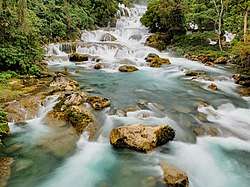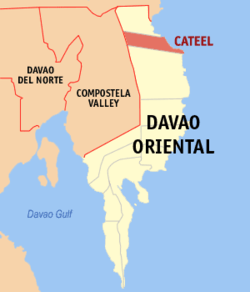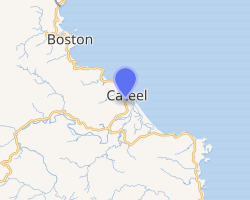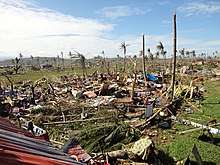Cateel
Cateel ([kɐtiʔil]), officially the Municipality of Cateel (Cebuano: Lungsod sa Cateel; Tagalog: Bayan ng Cateel), is a 2nd class municipality in the province of Davao Oriental, Philippines. According to the 2015 census, it has a population of 40,704 people.[3]
Cateel | |
|---|---|
| Municipality of Cateel | |
 Aliwagwag Falls | |
 Seal | |
 Map of Davao Oriental with Cateel highlighted | |
OpenStreetMap 
| |
.svg.png) Cateel Location within the Philippines | |
| Coordinates: 7°47′N 126°27′E | |
| Country | |
| Region | Davao Region (Region XI) |
| Province | Davao Oriental |
| District | 1st District |
| Founded | October 29, 1903 |
| Barangays | 16 (see Barangays) |
| Government | |
| • Type | Sangguniang Bayan |
| • Mayor | Erlinda C. Nuñez |
| • Vice Mayor | Camilo T. Nuñez |
| • Congressman | Corazon N. Malanyaon |
| • Electorate | 27,964 voters (2019) |
| Area | |
| • Total | 545.56 km2 (210.64 sq mi) |
| Population (2015 census)[3] | |
| • Total | 40,704 |
| • Density | 75/km2 (190/sq mi) |
| • Households | 9,694 |
| Economy | |
| • Income class | 2nd municipal income class |
| • Poverty incidence | 30.61% (2015)[4] |
| • Revenue (₱) | 137,649,998.41 (2016) |
| Time zone | UTC+8 (PST) |
| ZIP code | 8205 |
| PSGC | |
| IDD : area code | +63 (0)87 |
| Climate type | tropical rainforest climate |
| Native languages | Davawenyo Surigaonon Cebuano Kalagan language Kamayo Mandaya |
| Website | www |
Cateel is the home of the Aliwagwag Falls, located at barangay Aliwagwag within the Aliwagwag Protected Landscape. It is a towering waterfalls considered by hydraulic engineers as the highest in the country and regarded as one of the most beautiful falls in the Philippines. It is a series of 84 falls appearing like stairway to heaven with various heights among the steps ranging from 2 to 33.5 metres (7 to 110 ft). One step is measured 22 metres (72 ft) and another is 20 metres (66 ft). Overall Aliwagwag Falls has a height of 340 metres (1,120 ft) and a width of 20 metres (66 ft). All these in the midst of virgin forest, with a river at the foot of the falls. 13 rapids to cross.
History

Cateel is the first municipality in Mindanao. It was the place where Spaniards first docked in Mindanao which reflects how majority of its primary inhabitants converted to Catholicism.
In 1959,the Mainit and Alegria were converted into barrios.[5]
The municipality was one of the hardest-hit towns of Typhoon Bopha when it hit the town on December 3, 2012.[6]
Barangays
Cateel is politically subdivided into 16 barangays.
- Abihod
- Alegria
- Aliwagwag
- Aragon
- Baybay
- Maglahus
- Mainit
- Malibago
- San Alfonso
- San Antonio
- San Miguel
- San Rafael
- San Vicente
- Santa Filomena
- Taytayan
- Poblacion
Demographics
|
| ||||||||||||||||||||||||||||||||||||||||||||||||
| Source: Philippine Statistics Authority[3][7][8][9] | |||||||||||||||||||||||||||||||||||||||||||||||||
Climate
| Climate data for Cateel, Davao Oriental | |||||||||||||
|---|---|---|---|---|---|---|---|---|---|---|---|---|---|
| Month | Jan | Feb | Mar | Apr | May | Jun | Jul | Aug | Sep | Oct | Nov | Dec | Year |
| Average high °C (°F) | 27 (81) |
27 (81) |
28 (82) |
30 (86) |
30 (86) |
30 (86) |
30 (86) |
30 (86) |
30 (86) |
30 (86) |
29 (84) |
28 (82) |
29 (84) |
| Average low °C (°F) | 23 (73) |
23 (73) |
23 (73) |
23 (73) |
24 (75) |
24 (75) |
24 (75) |
24 (75) |
24 (75) |
24 (75) |
24 (75) |
24 (75) |
24 (74) |
| Average precipitation mm (inches) | 160 (6.3) |
127 (5.0) |
96 (3.8) |
62 (2.4) |
141 (5.6) |
197 (7.8) |
185 (7.3) |
186 (7.3) |
183 (7.2) |
181 (7.1) |
128 (5.0) |
111 (4.4) |
1,757 (69.2) |
| Average rainy days | 20.0 | 17.2 | 15.9 | 13.9 | 23.8 | 27.2 | 28.1 | 28.2 | 27.0 | 27.0 | 21.3 | 18.7 | 268.3 |
| Source: Meteoblue (modeled/calculated data, not measured locally) [10] | |||||||||||||
References
- "Municipality". Quezon City, Philippines: Department of the Interior and Local Government. Retrieved 31 May 2013.
- "Province: Davao Oriental". PSGC Interactive. Quezon City, Philippines: Philippine Statistics Authority. Retrieved 12 November 2016.
- Census of Population (2015). "Region XI (Davao Region)". Total Population by Province, City, Municipality and Barangay. PSA. Retrieved 20 June 2016.
- "PSA releases the 2015 Municipal and City Level Poverty Estimates". Quezon City, Philippines. Retrieved 12 October 2019.
- "R.A. No. 2105, An Act Creating Certain Barrios in the Municipality of Cateel, Province of Davao". LawPH.com. Retrieved 2011-04-13.
- "Typhoon death toll climbs to over 200". Philippine Daily Inquirer. Retrieved 5 December 2012.
- Census of Population and Housing (2010). "Region XI (Davao Region)". Total Population by Province, City, Municipality and Barangay. NSO. Retrieved 29 June 2016.
- Censuses of Population (1903–2007). "Region XI (Davao Region)". Table 1. Population Enumerated in Various Censuses by Province/Highly Urbanized City: 1903 to 2007. NSO.
- "Province of Davao Oriental". Municipality Population Data. Local Water Utilities Administration Research Division. Retrieved 17 December 2016.
- "Cateel: Average Temperatures and Rainfall". Meteoblue. Retrieved 17 November 2019.
External links
| Wikimedia Commons has media related to Cateel. |